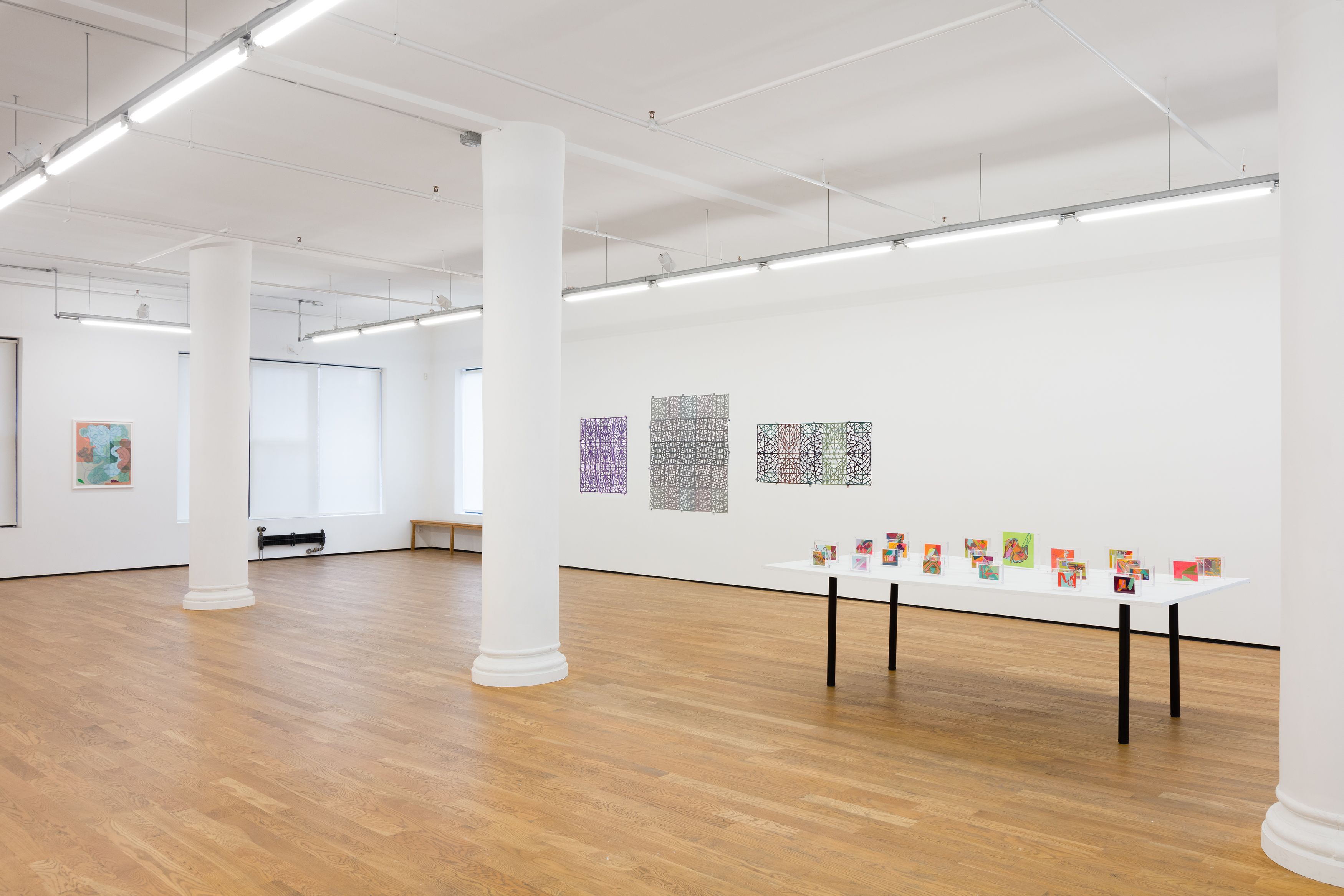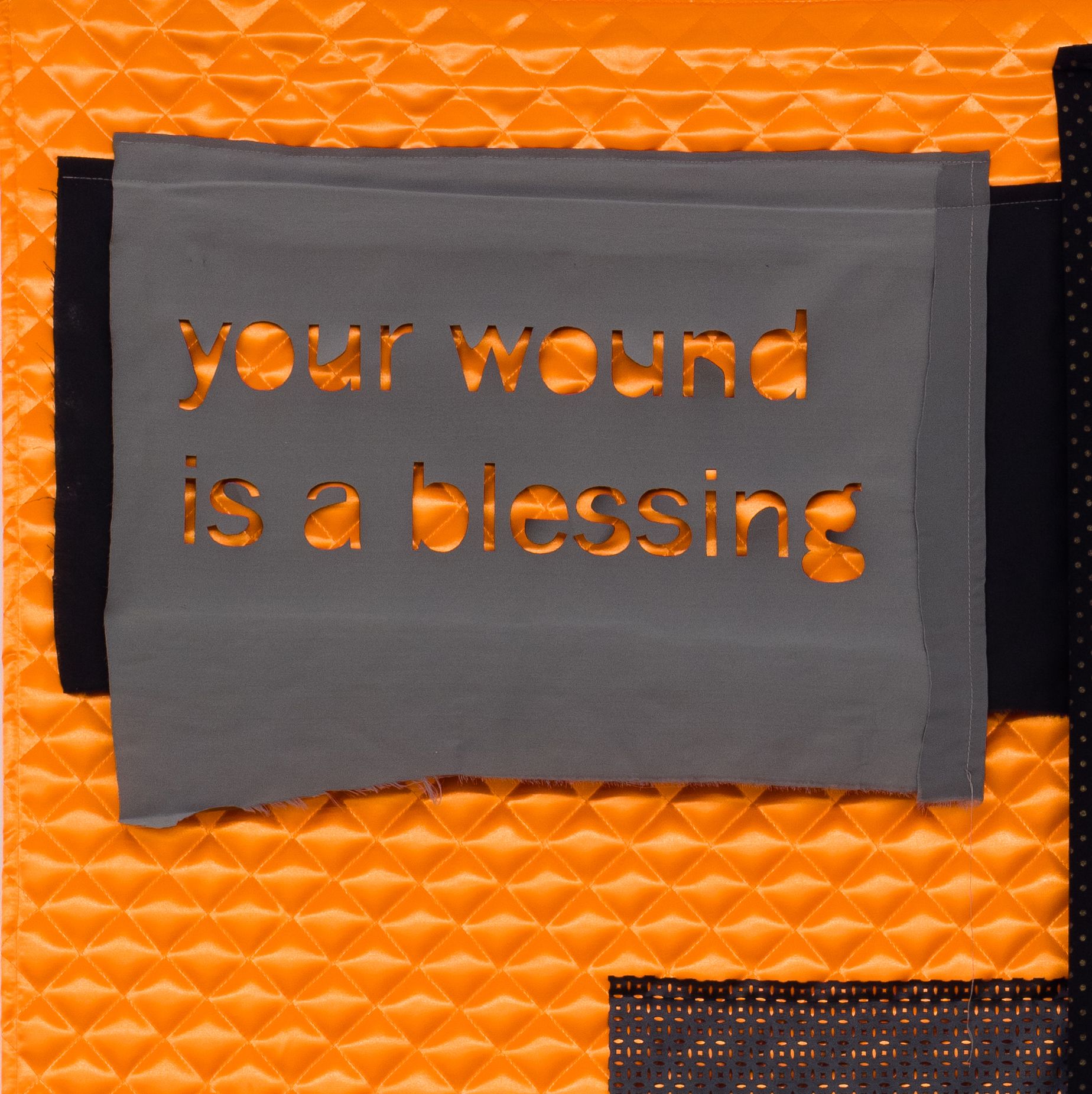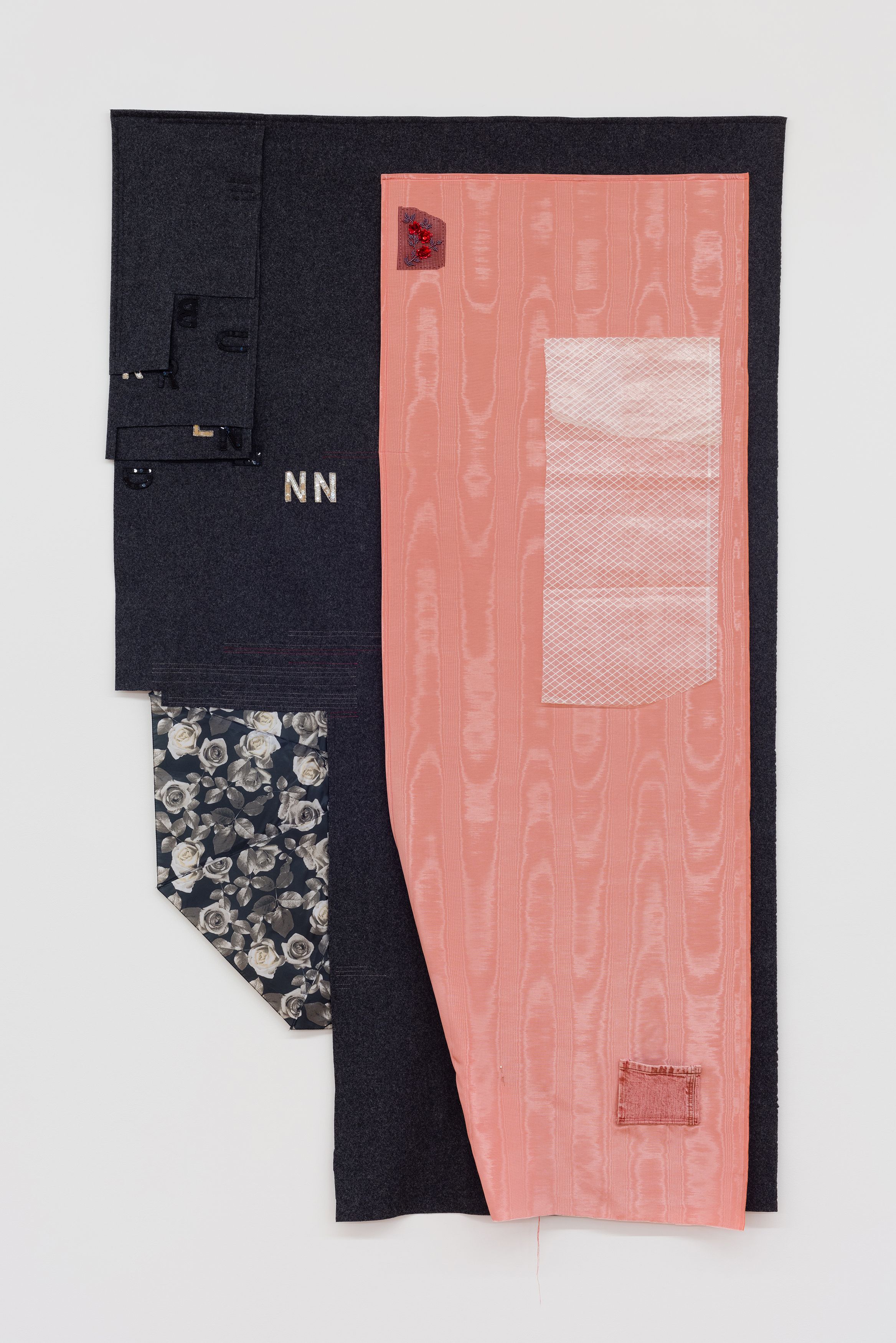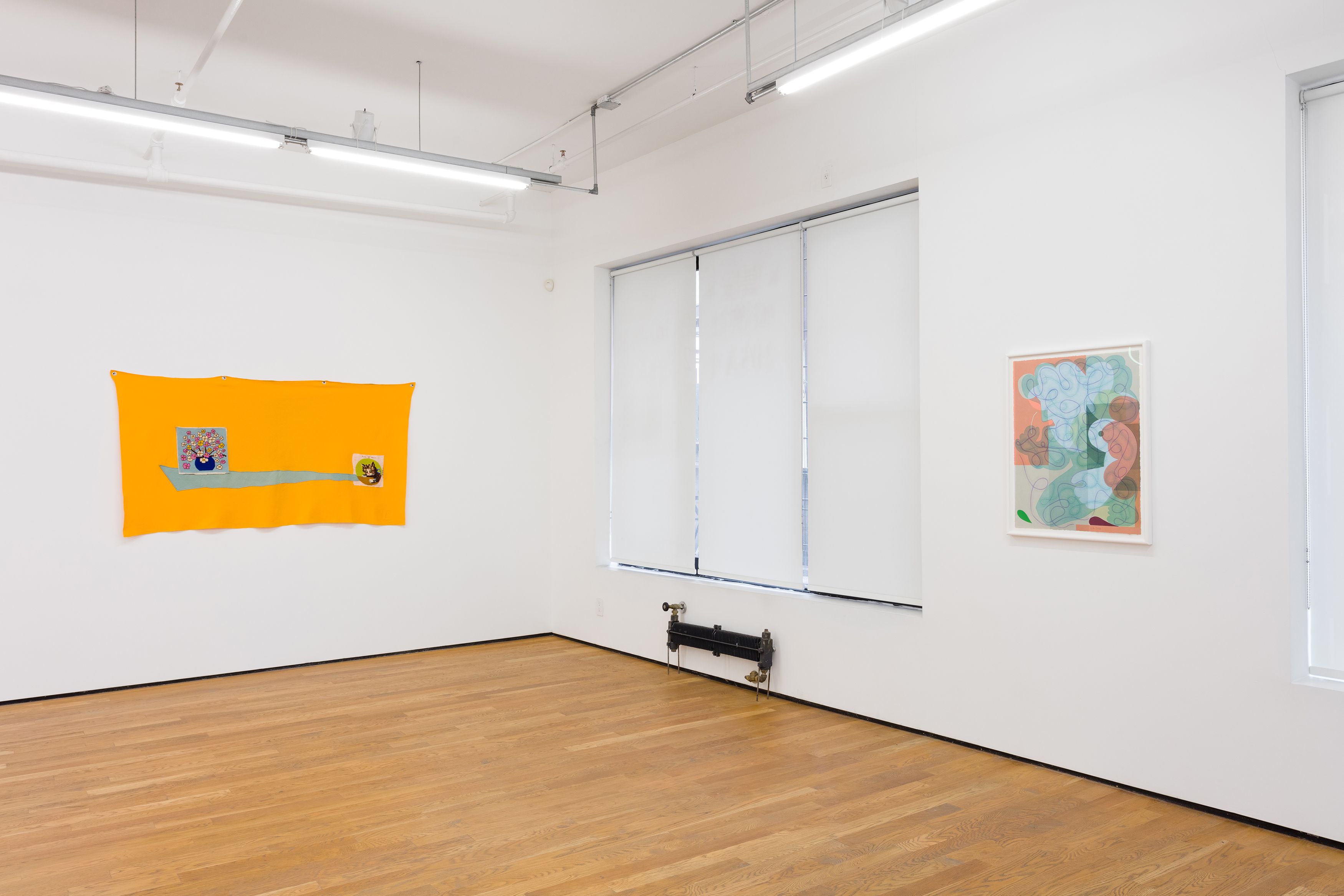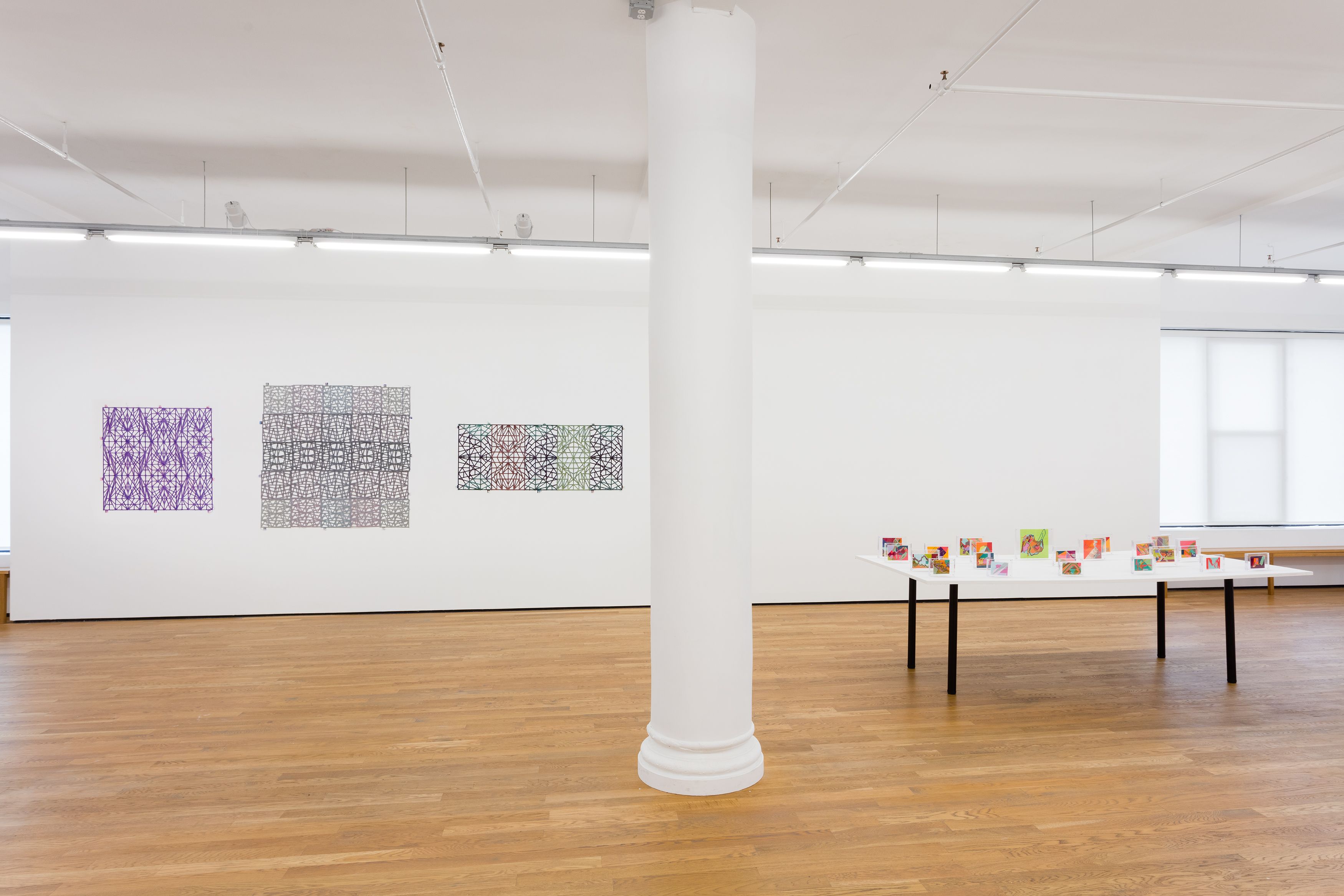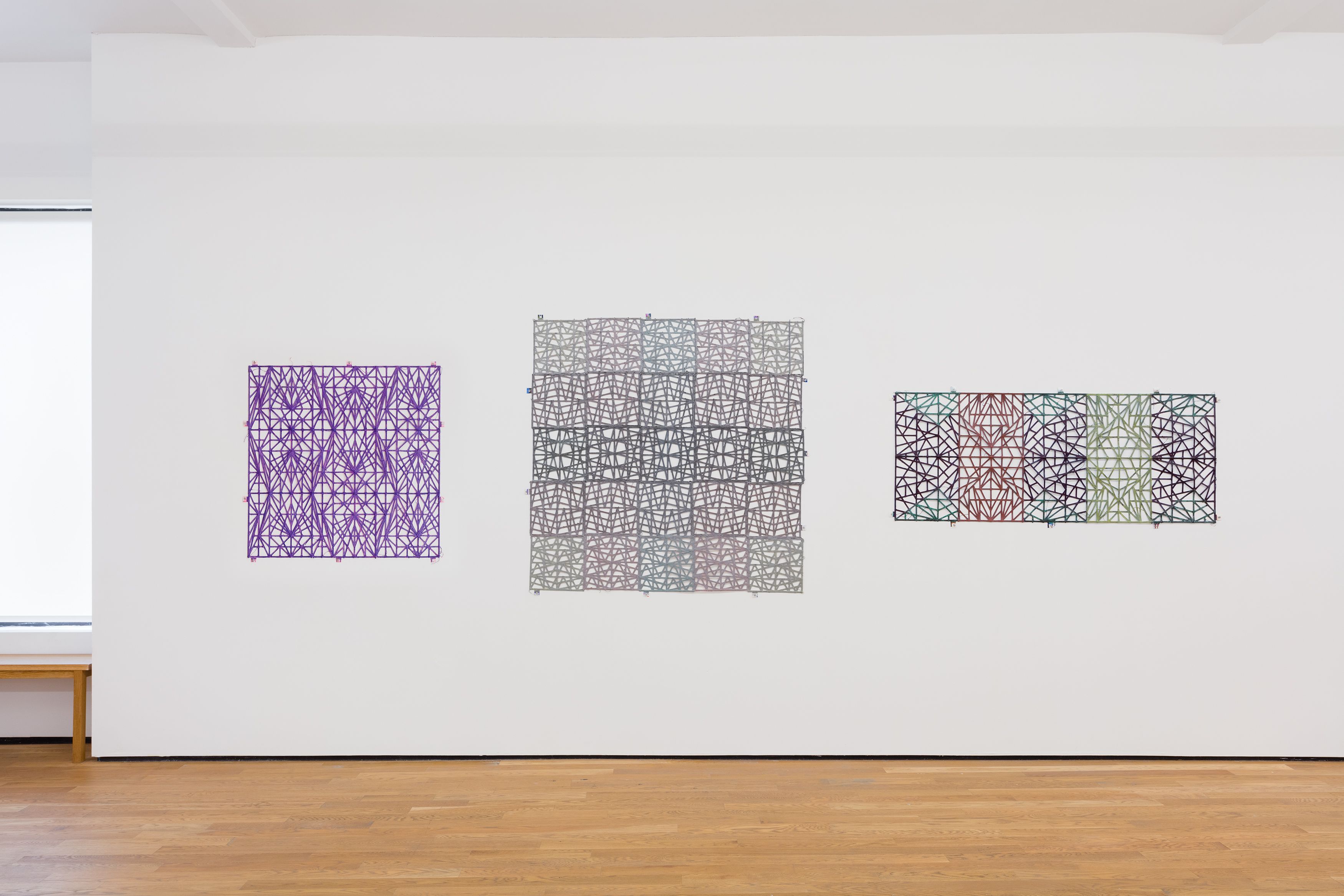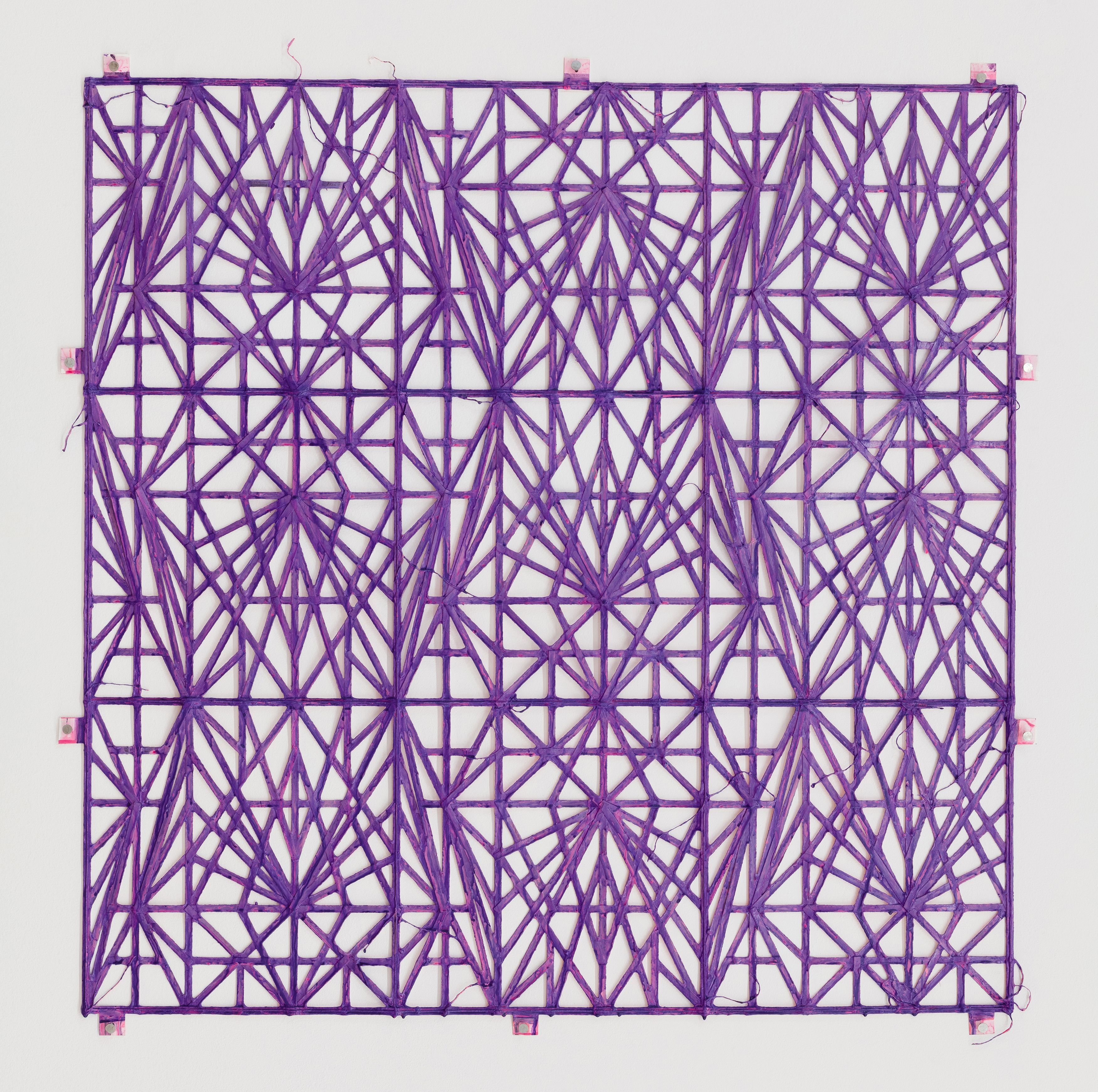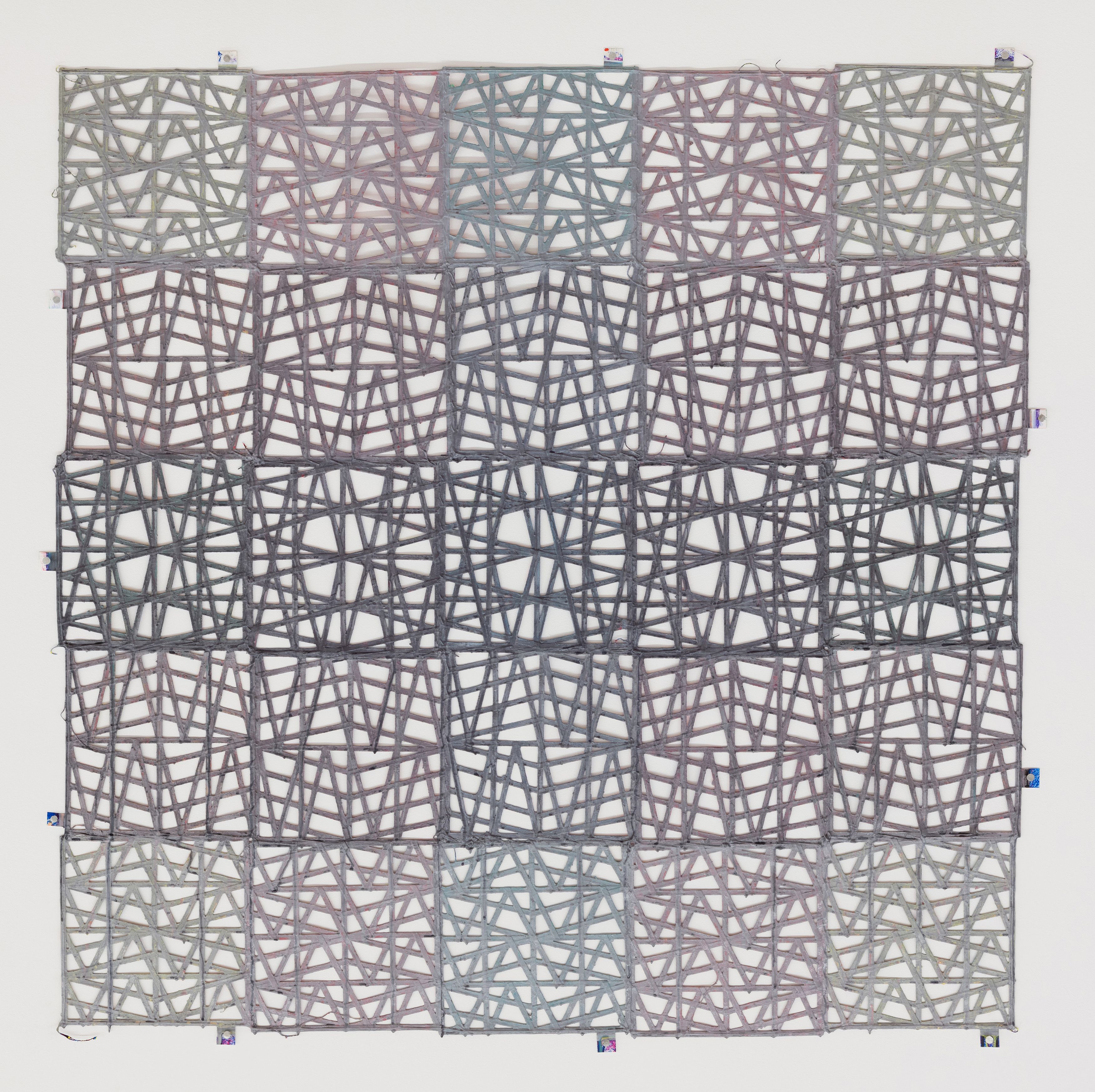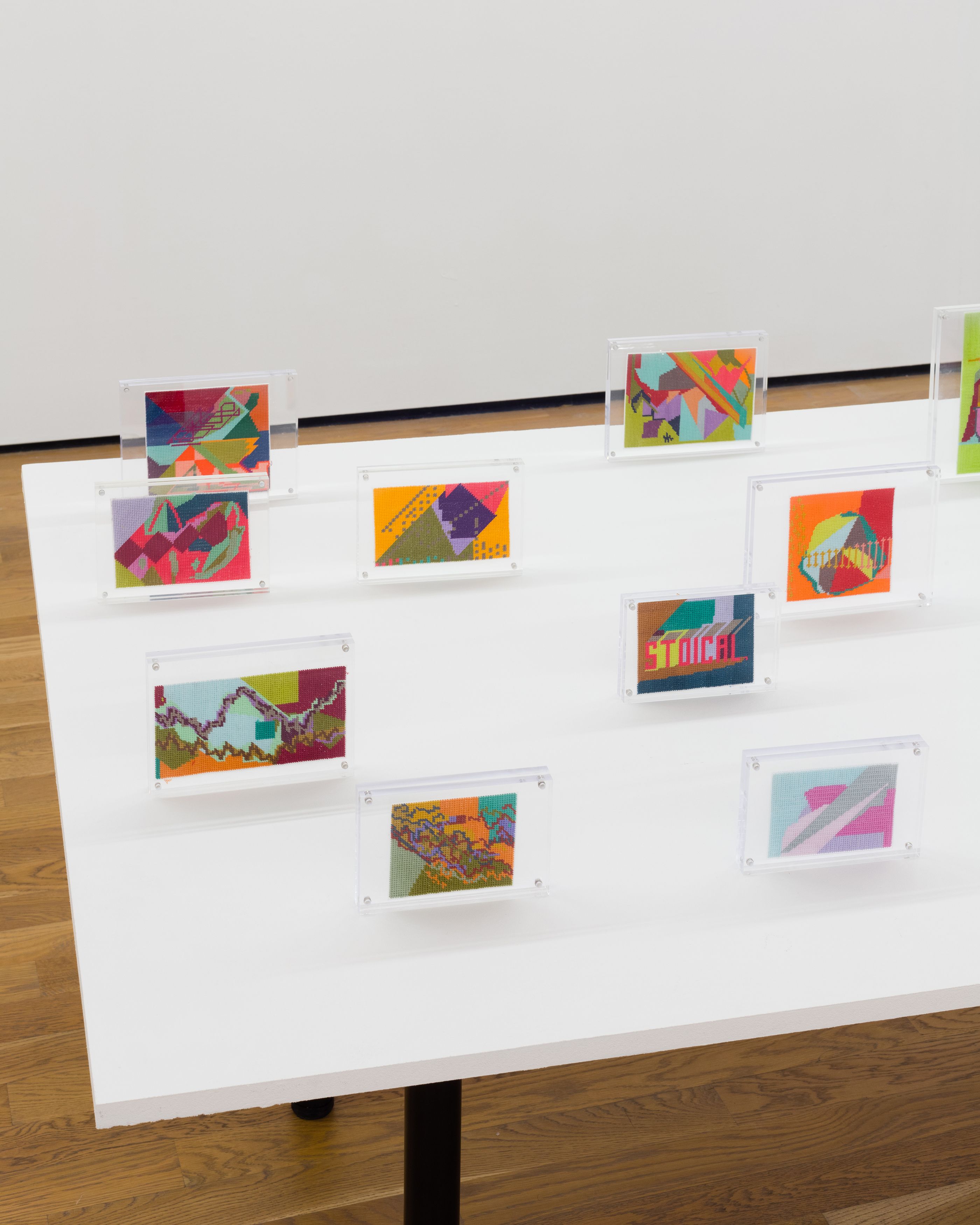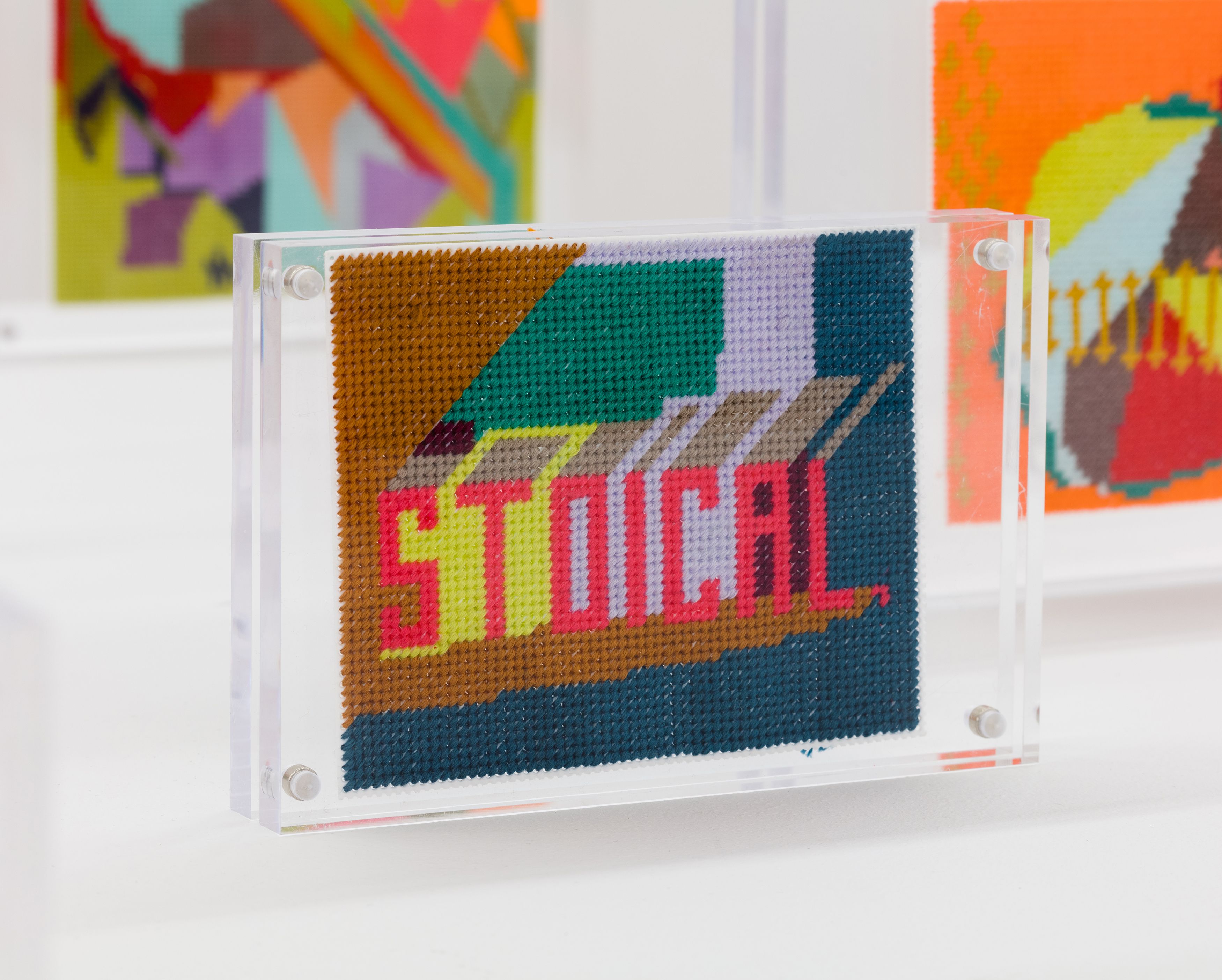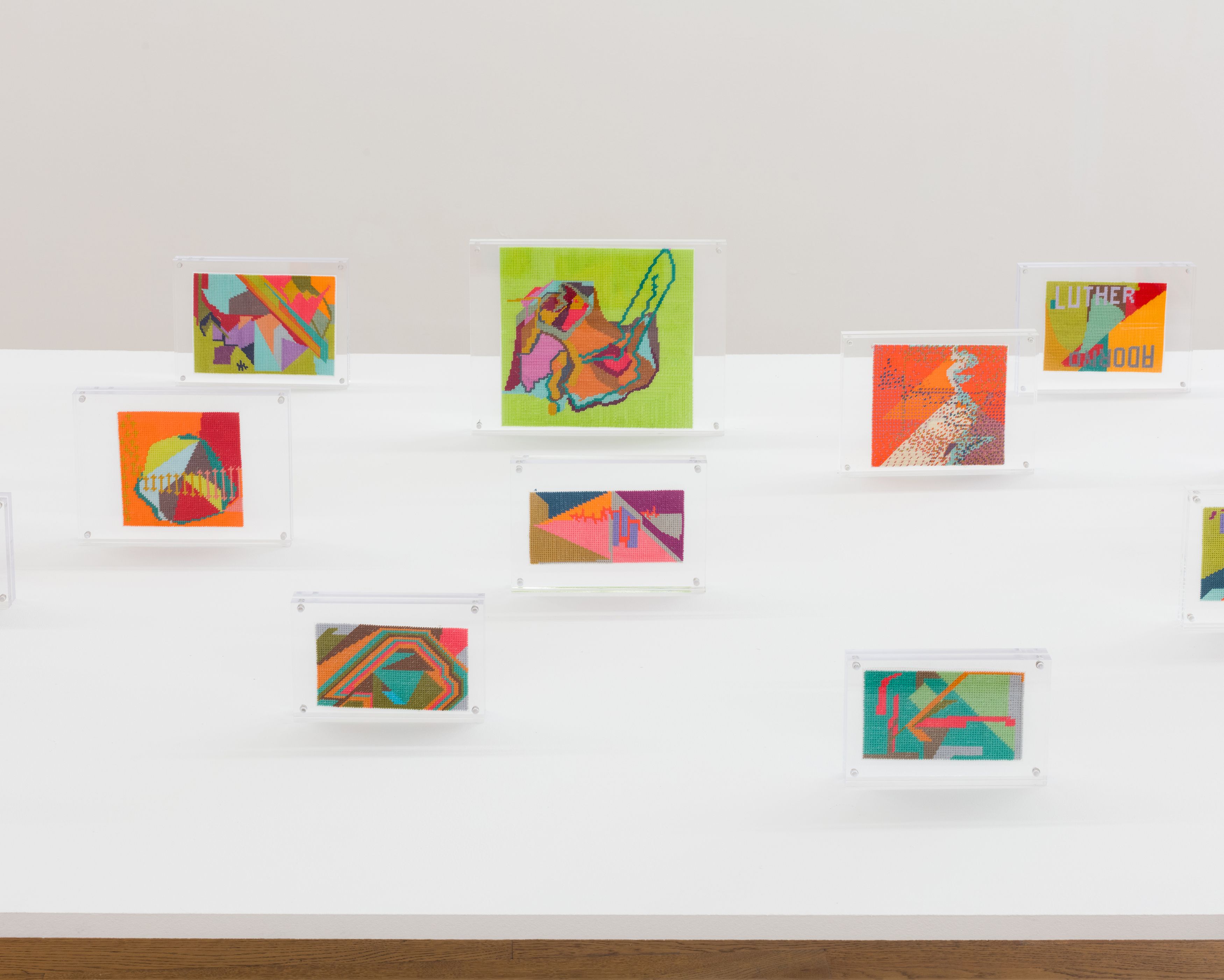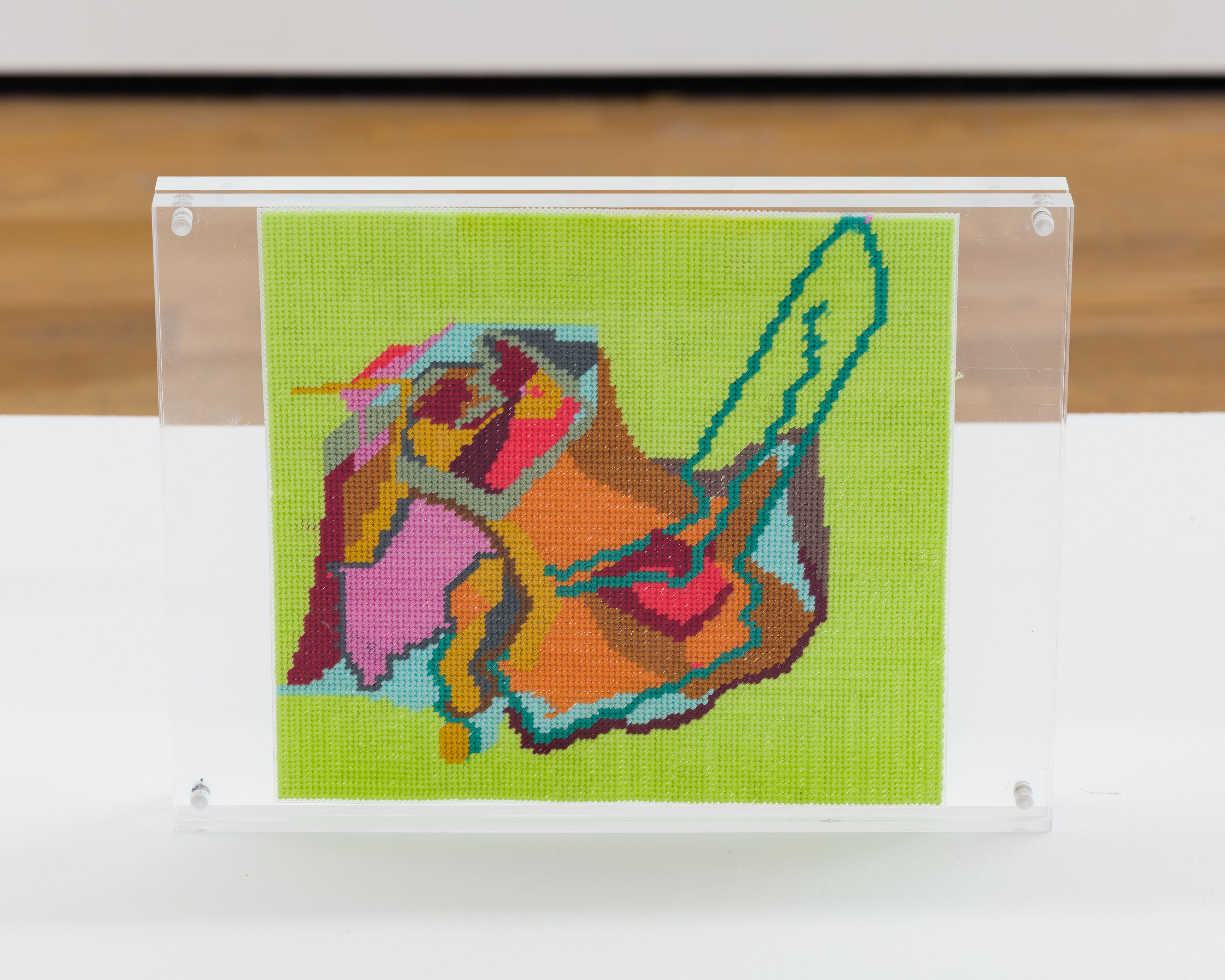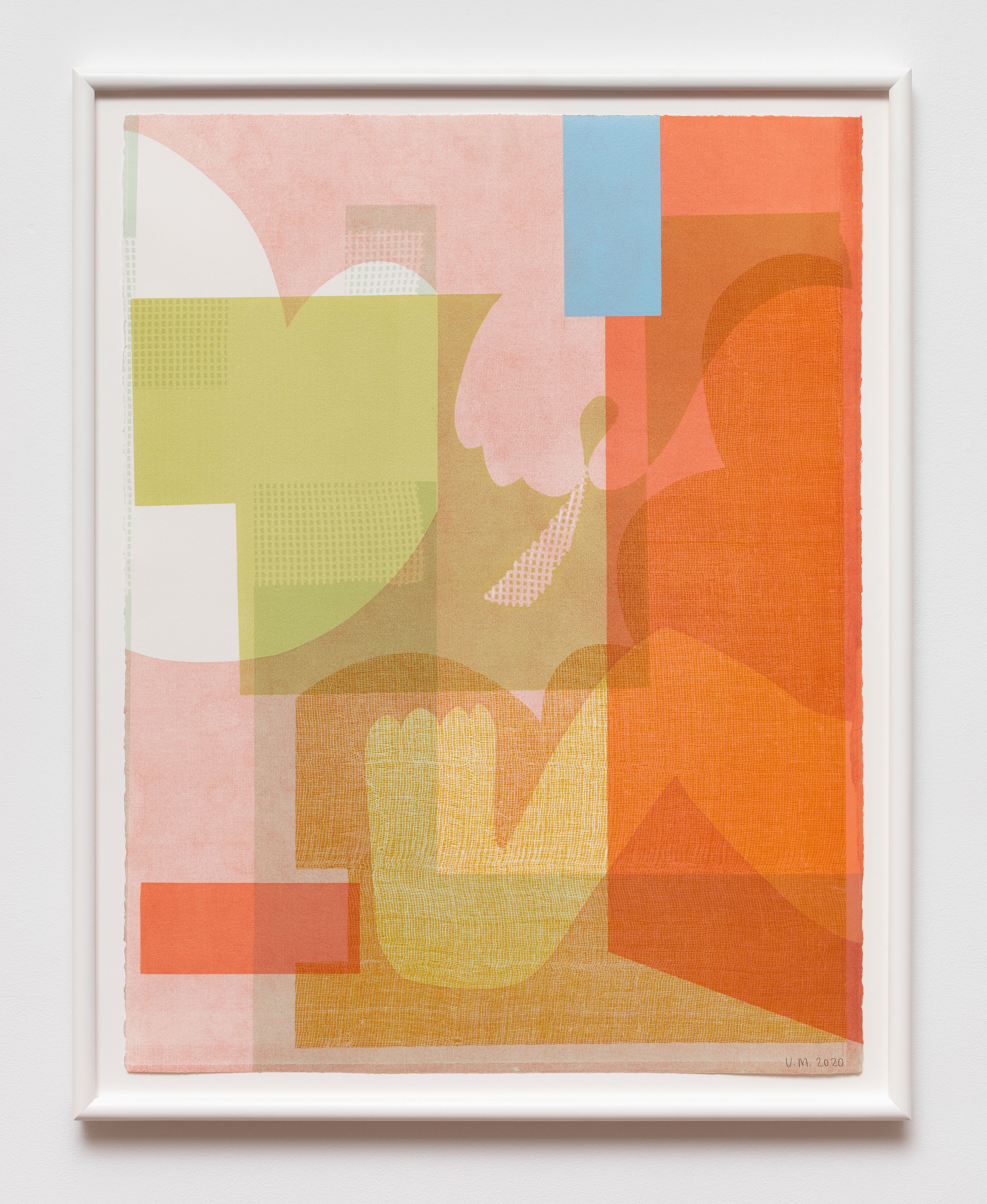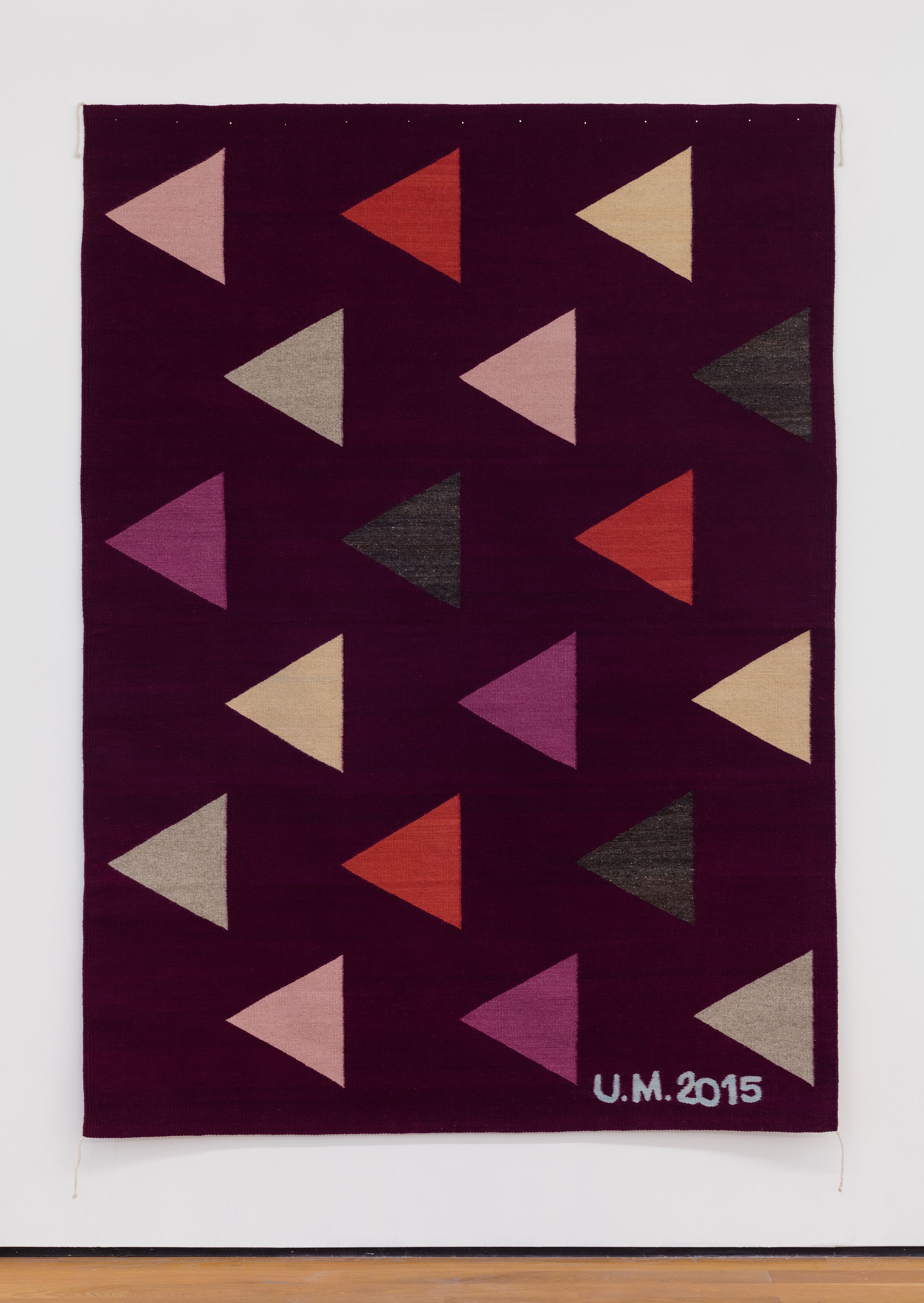Steve Reinke, Tuesday Smillie 20 January 2021 - 21 March 2021
Hours: Wednesday – Sunday, 11-6PM. Click here to make an appointment." Walk-ins are also welcome, space permitting. Click here for further info.
Threads is a group exhibition of works using textiles to visualize conceptual systems that are both personal and communal: where threads, bound together to make fabric, are lines constructing an imaginary that is reflective, questioning, and activating. The exhibition incorporates texture, pattern, and sometimes text that can be both symbolic and abstract, while retaining a tangible connection to narrative and material.
Ulrike Müller
Ulrike Müller presents three works that imply both geometry and figuration: a wall-based woven rug with a dynamic pattern of triangles, and two printed works on paper that suggest threads and weaves. The artist’s forms are both diagrammatic and affecting, abstract shapes that suggest bonds among people that may be emotional, social, and sensual.
Ulrike Müller engages relationships between signification and bodies, and a concept of painting that is not restricted to brush and canvas. Employing a wide range of materials and techniques, including performance, publishing, and textiles, her work moves between different contexts and publics, invites collaboration, and expands to unexpected realms of production in processes of exploration and exchange.
Ulrike Müller (Brixlegg, Austria, 1971) live and works in Brooklyn, NY. Müller studied art at the Academy of Fine Arts Vienna, Austria, and participated in the Whitney Museum Independent Study Program, New York. Exhibitions include a commission at the Queens Museum, Queens, NY (2020); “May You Live In Interesting Times,” curated by Ralph Rugoff, Venice Biennale, International Pavilion, Venice, Italy; The Galleries at Moore College of Art & Design, Philadelphia, PA (solo)(both 2019); the Whitney Biennial, New York, NY; Kunstverein Düsseldorf, Germany (solo); “Trigger: Gender as a Tool and a Weapon,” New Museum, New York, NY (all 2017); Callicoon Fine Arts, New York, NY (2016); and mumok – Museum of Modern Art Ludwig Foundation, Vienna, Austria (solo)(2015).
Johnathan Payne
Johnathan Payne presents three painted grids made from collaged paper and thread. Their subtly monochrome coloring on closer inspection reveals a mix of various hues. The works visualize interconnectivity, suggesting interlacing roads, motherboards, or neurons: technologies that allow people to intercept and interact with one another. The works’ tactile and painterly natures afford them a visceral character that transcends abstraction.
“The work’s relationship to textiles is a broad one. I don’t have a formal background in textile work or sewing. I grew interested in fibers as a conceptual and formal material upon discovering their visual radicalism. Technically paper is a fiber, but I digress. I wanted to emulate some of the qualities I was seeing in fiber sculpture, rugs, and quilts in my collage works, particularly with regard to pattern and color. I began to think about the paper shred as a unit, a line that can be infinitely augmented and replicated, like stitched thread. My works are translations of traditional weavings, but are distinct in their materiality, process and logic. Weaving also informs my approach to painting, where I create color relationships by layering diluted paints atop one another. The demarcations in color work are minimally visible at a distance, but become more apparent in their complexity the closer a viewer stands to the work. This feels synonymous with the macro- and micro-visual qualities of weavings and fibrous materials.
At the core of this work is the desire to construct an idiosyncratic Queer aesthetic that is grounded in discipline, labor and abstraction. I gravitate towards geometric abstraction in particular for its complexity, connectivity, and iconic visual style. The grid, a visual symbol of stability and integrity, affords me a structure that I can choreograph in limitless ways. This infiniteness of formal potentiality has as much to do with painting (and art-making more generally) as it does with my personhood, and the reckoning with and re-orienting of our current systems.”
Johnathan Payne, January 2021
Johnathan Payne works across drawing, painting, fibers, and installation, and engages in traditional and alternative modes of object and image production. His abstractions occupy a space of radical formalism where methodology, experimentation, and craft converge. Payne’s art practice oscillates between—and derives influence from—painting, sculpture, 2D design, and textile arts. Craft-affirming art movements such as Pattern and Decoration, as well as the schools of Bauhaus and Black Mountain College, also underpin Payne’s approach to art-making.
Johnathan Payne (Houston, TX, 1991) currently lives and works in Iowa City, IA. He holds a BA in art from Rhodes College, Memphis, TN, and an MFA in painting and printmaking from Yale School of Art, New Haven, CT. Exhibitions include “Miss Lizzie’s Lattice” with Lex Brown, Deli Gallery, New York, NY (2020); “Kink and Politics: The Ties That Bind,”curated by Wardell Milan, David Nolan Gallery, New York, NY (2017); and “Meet Me Where I’m At,” Crosstown Arts, Memphis, TN (solo)(2015).
Steve Reinke
Steve Reinke’s Needlepoints are colorful, semi-abstract grids that sometimes incorporate poetic text. Needlepoint predates painting by thousands of years and is considered the original canvas-based art form. After becoming popular among aristocratic women, it grew to be a popular feminine craft that was undervalued and critically overlooked. Reinke’s Needlepoints are obsessive actions that seem to spring directly from his subconscious. Rather than aspiring to be abstract, Reinke says they actually resist patterning:
I used to doodle a lot, but I don’t doodle so much any more. I am too old to doodle; instead,
I needlepoint. I have a bunch of colorful thread, which they call floss, and a firm plastic backing. I get to work without a plan, without a thought, without a care. If a pattern emerges — and one generally does — it develops so slowly that I begin to lose interest and begin to do something else, fucking it up. It takes an hour to do an inch. These are really slow doodles, crafty doodles. Sloppiness is part of the charm. I rarely frame them because I want to be able to turn them over and see their soft underbellies. One could argue that the front is the ego and the bottom is the id, but that is not quite right. Perhaps the back is the Dionysian supplement to the Apollonian perfection of the front. No, no, that makes even less sense. Perhaps they should all just be framed so they can the happy simple life of pictures and not have the burden of objecthood at all. They do mark time, though. I have drawer after drawer of them. They are thoughtless and charming, innocent, undemanding. I can’t exactly say they are life affirming, since they seem to mark a certain indolence, a slight distraction in the slide toward an easy grave. They are much the prettiest, most well-behaved children and so I want to introduce them to you, front and back. I don’t want to stitch them into a giant cushion, I want to use them to stuff the gap between the preconscious and the conscious and then the gap between the unconscious and the preconscious, until they take over your whole psychic life and you become some kind of needlepoint zombie, thinking only texture and abandoned pattern.
Steve Reinke
Reinke also presents a textile work where he places found needlepoints on a felt background. A slightly crazed-looking cat is positioned at one end of a geometric shape while a bunch of flowers is at the other. The artist makes a dialog between two prosaic craft images that is humorous, abstracted, and a little unnerving.
Steve Reinke is best known for his monologue-based videos that blur the boundary between documentary and fiction. In over five hours of video material, his “The Hundred Videos” (1989–1996) combines found, filmed, and animated images with confessional comments. In 2006, Reinke started a new cycle titled “Final Thoughts” which will be concluded at the time of the artist’s death. Questions of libido and eros are central to earlier works, while Final Thoughts is dedicated to their opposite – to mortality.
Steve Reinke (Eganville, ON, Canada, 1963) lives and works in Chicago, IL. He holds a BFA from York University, Toronto, ON, Canada, and an MFA from Nova Scotia College of Art and Design, Halifax, NS, Canada. Exhibitions include “Butter,” MUMOK, Vienna, Austria (solo)(2020); Welsh Pavilion of the Venice Biennale with James Richards (2017); Western Exhibitions, Chicago, IL (solo)(2017); Isabella Bortollozzi, Berlin, Germany (solo)(2016): and the Whitney Biennial, New York, NY (2014).
Tuesday Smillie
Tuesday Smillie presents two wall-based works that combine textiles and text. Wound comprises a range of found materials, including orange quilted and black perforated fabric, and strings of golden beads, with the saying at the top: “Your Wound Is a Blessing,” echoing an invocation for those in bereavement. Her work Burden is likewise a collage of materials, with a repeated rose motif, the initials ‘NN” sewn in lamé, and salmon moiré fabric with a pocket and a pin suggesting a garment in construction, or one that has expanded all the received definitions of what clothing may be.
Tuesday Smillie is a visual artist working with textiles, collage, printmaking and watercolor. At the core of her work is a question about the individual and the group: the binary of inclusion and exclusion. and the porous membrane between the two.
Tuesday Smillie (Boston, MA, 1981) lives and works in Brooklyn, NY. In 2018 she had solo exhibitions at the Rose Art Museum. Waltham, MA, and Participant Inc, New York. Her work has shown at the New Museum, New York; Brooklyn Museum, New York; Museu de Arte de São Paulo, Brazil; The Jewish Museum, New York; and will be featured in an upcoming exhibition at Haus der Kunst, Munich, Germany. Smillie has been an artist resident at the Rauschenberg Foundation, Captiva, FL (2020), and Abrons Art Center, New York (2018-19).
With many thanks fo Callicoon Fine Arts, New York, NY, and Galerie Isabella Bortolozzi, Berlin, Germany.
CREDITS
Photography: Charles Benton.
